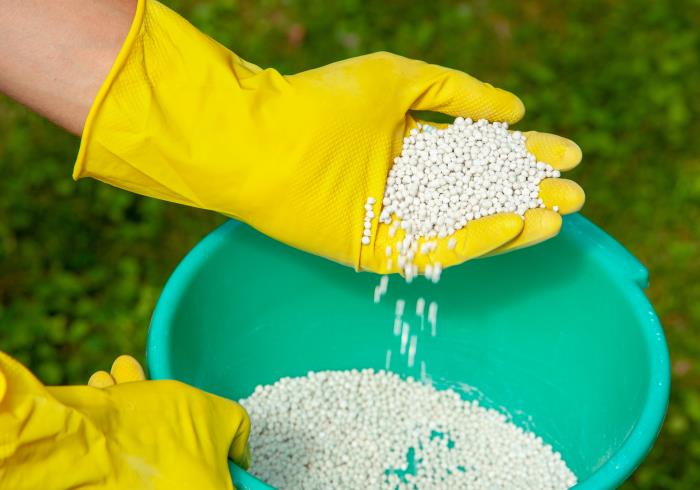If you garden, it’s most likely you have old or excess fertilizer you’re not sure how to dispose of.
Tossing fertilizer into the trash can be unsafe. Haphazardly spreading old fertilizer around your garden could be harmful to both the plants and soil conditions you work so hard to keep in top condition.

So what’s the solution? You’ll find it right here in this fertilizer disposal guide.
Inside, I explain what to consider before getting rid of fertilizer, supplies you’ll need, and the steps to perform the task safely without harming the environment.
Taking a few minutes to deal with unwanted fertilizer properly is worth the effort, so let’s begin!
What To Consider
There are things you must consider when getting rid of fertilizer that is old or you don’t need for your lawn or garden.
Type Of Fertilizer
First, you need to look at the fertilizer ingredients. Are they organic and safe for the environment, or are they made from chemicals or biosolids (treated sewage sludge)?
It may seem confusing to learn that all chemical and biosolid fertilizer is considered to be hazardous waste, even though it’s safe to use in moderation on our plants.
The reason is that the high concentration of nitrogen and phosphorus found in most fertilizers can create problems when they get into waterways.
Related | How To Add Nitrogen To Soil
Algae blooms and excessive weed growth can overtake a pond, stream, lake, or ocean depriving aquatic life of critical oxygen, which can lead to death.
Dealing With Organic Fertilizers
Luckily, getting rid of excess organic fertilizer is as simple as mixing it in your compost pile in small portions or spreading it out very thinly around your entire yard and garden.
The natural ingredients should quickly break down and give all your plants a little boost of helpful nutrients.
Tips For Getting Rid Of Chemical Or Biosolid Fertilizer
The right way:
- Do try to give fertilizer away to other gardeners, local plant nurseries, or garden stores who could use it
- Do check with local waste management services about hazardous-waste pick-up days or drop-off locations
- Do consider watering down hard, old fertilizer to use sparingly on houseplants and struggling garden plants as the chemicals inside are still active
- Do alert staff at the local dump if your trash contains any amount of fertilizer
The wrong way:
- Don’t dump it in a pile in your yard, garden, or compost – it can cause chemical burns to plants it contacts and kills off beneficial microbes
- Don’t pour liquid fertilizer down the sink or sewer drain
- Don’t dump liquid or granular fertilizer directly into the trash
- Don’t allow children or pets near the fertilizer
- Don’t assume dumping a large quantity of “natural” fertilizer in one location is safe for plants
- Don’t ever mix different types of fertilizers, as a dangerous chemical reaction can occur
How To Dispose Of Old Fertilizer
Follow our quick and easy directions below to dispose of old fertilizer that does not contain any pesticides or high levels of phosphorous.
If your fertilizer does not meet this requirement, you’ll need to dispose of it through your local household hazardous waste division.
By doing your part, you can help reduce contamination as the fertilizer waste makes its way through the garbage collection system.
Related | Does Fertilizer Expire?
What You Need
- Thick plastic trash bags or large ziptop bags
- Newspaper
- Tape
- Original fertilizer containers or bags
Step 1 – Collect Old Fertilizer
Gather up all the chemical or biosolid fertilizer you wish to dispose of from your gardening shed, garage, basement, or other storage areas.
Try to keep fertilizer in its original container or bag, making sure it doesn’t mix with others you are throwing away.
For liquid fertilizer, start by ensuring the lid is on tight. Use tape around the opening to keep the top from unscrewing.
For granular fertilizers inside a plastic bag, roll down the bag tightly and tape it shut. If the fertilizer is loose in a box, pour it into a ziptop bag.
WARNING: Make sure you avoid touching or inhaling fumes or dust from the fertilizer or letting it get into your eyes.
Step 2 – Lay Out Newspaper
Spread out sheets of newspaper at least three layers thick. Wrap all your fertilizer bags or bottles individually inside the layers, using tape to hold them shut.
Sealing the fertilizer in paper adds another layer of protection against spills or leaks.
For liquid fertilizer, use enough sheets of paper to soak up any liquid that could potentially seep from the container as it travels from your garbage bin to the truck, through the crusher, and to the dump.
Step 3 – Double Seal Each Item
Open up a plastic trash or Ziplock bag large enough to completely seal around each newspaper-wrapped bag or bottle of fertilizer.
Place the fertilizer inside the bag and tie off the bag or zip the bag seal shut. Use tape to secure the seal on the bag to prevent any fertilizer from falling out.
If the plastic bag is thin, you may want to consider creating another layer of newspaper around the whole unit and place it all into another plastic bag to complete the process.
At this point, you can now safely place the fertilizer in your garbage for regular pick-up. If any leaks occur, the plastic bag and newspaper should help corral the material so it can’t escape and wash into waterways.
In Summary
When you have extra fertilizer from your gardening projects, always try to use the material yourself or give it away to someone whose plants can benefit from the nutrients.
Throwing fertilizer in the garbage should be a last resort. When the need arises, you now know how to dispose of fertilizer to prevent harm to our environment. Doing all you can to keep our waterways clean is part of being a mindful gardener!










